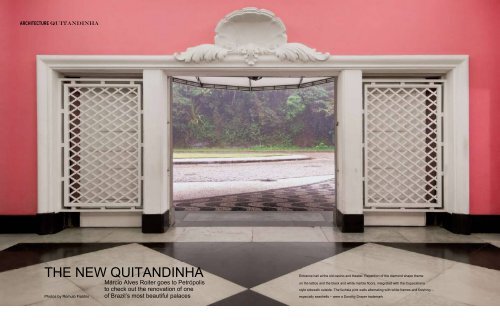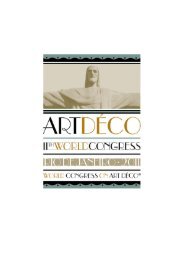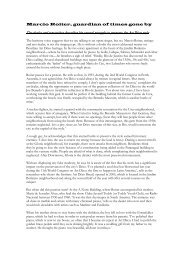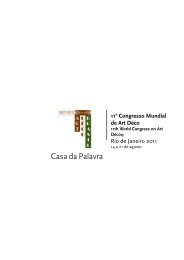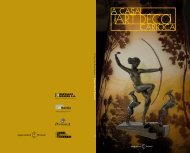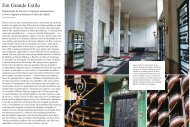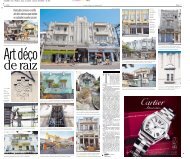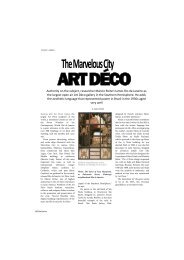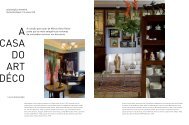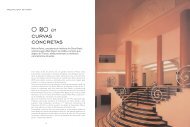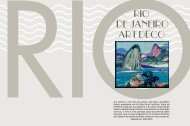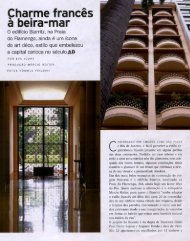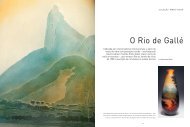THE NEW QUITANDINHA - Instituto Art Deco Brasil
THE NEW QUITANDINHA - Instituto Art Deco Brasil
THE NEW QUITANDINHA - Instituto Art Deco Brasil
You also want an ePaper? Increase the reach of your titles
YUMPU automatically turns print PDFs into web optimized ePapers that Google loves.
ARCHITECTURE <strong>QUITANDINHA</strong><br />
<strong>THE</strong> <strong>NEW</strong> <strong>QUITANDINHA</strong><br />
Entrance hall at the old casino and theater. Repetition of the diamond shape theme<br />
on the lattice and the black and white marble floors, integrated with the Copacabana<br />
MÄrcio Alves Roiter goes to PetrÅpolis<br />
to check out the renovation of one style sidewalk outside. The fuchsia pink walls alternating with white frames and finishing –<br />
Photos by Romulo Fialdini of Brazil’s most beautiful palaces especially seashells – were a Dorothy Draper trademark
ARCHITECTURE <strong>QUITANDINHA</strong><br />
The sign on Rio-PetrÅpolis road indicates, laconically: Quitandinha Palace. Even if we could read<br />
what Cholly Knickerbocker wrote on the New York Journal, in 1944, the year when the largest<br />
resort and casino in Latin America was opened, we would not be prepared for what we were<br />
about to see. And the social columnist had solemnly stated: “Southern hemisphere’s Monte<br />
Carlo, Quitandinha is like a dream right out of The Arabian Nights or The Wizard of Oz.”<br />
The old casino, which would start to wither only two years later due to president Dutra’s decree<br />
forbidding gambling, has gone through an extensive renovation and now hold exhibits, parties,<br />
events, besides lectures promoted by Casa do Saber. Wish traveled to PetrÅpolis to see up close<br />
the transformation of one of the most beautiful Brazilian buildings.<br />
For a long time many asked what would happen to the palace, which had become during the<br />
1960s the Santa Paula Quitandinha Club, but bore no resemblance to the shinning glory of the<br />
1940s. In 2007, Sesc, a Brazilian commerce organization, acquired Quitandinha’s common areas<br />
– all the halls and installations except for the apartments – and has been conducting a detailed<br />
restoration project.<br />
On this page, above, the old casino’s Hollywood style staircase, floor with a mosaic created with<br />
several types of marble, with huge and intricately carved painted wooden candle-holders. All of the<br />
furniture was made by Brazilian cabinet-makers and craftsmen, following the designed by DD; to the<br />
left, black marble stairs to the theater, and empty lit niche, another resource present in the decorator’s<br />
vocabulary<br />
On the next page, sitting 1200 people, the theater is entirely original. The ceiling, with its consecutive<br />
concave layers, repeats the aesthetic/acoustic effect created inside New York’s Radio City Music Hall<br />
(1932) and Cinema Roxy in Copacabana (1938). Recently, it was used as a location for television series<br />
Dalva and Herivelto
ARCHITECTURE <strong>QUITANDINHA</strong><br />
It is almost done, and already houses intense cultural activity. Anti-minimalism Palace,<br />
Quitandinha is considered the world’s largest example of an encounter between international<br />
<strong>Art</strong> DÜco and Brazilian Baroque. It has been studied and visited by admirers of the first great<br />
American decorator, Dorothy Draper. After a forty-year career, she would realize there her<br />
most ambitious project.<br />
NÜe Dorothy Tuckerman, in 1889, to the gilded New York high-society, heir to the developer<br />
of the Tuxedo Park (an exclusive condominium 20 kilometers from Manhattan), Dorothy<br />
married future American president Franklin Delano Roosevelt’s personal doctor, George<br />
Draper, in 1912. Upon her divorce, 17 years later, she had to reinvent herself – which led<br />
her to coin the phrase: “American women are divided into two classes, the happily married<br />
and the decorators.”<br />
Her bold style and the success of projects like the Hampshire House hotels, on Central Park<br />
South, the Carlyle, on Upper East Side, both in New York, the Fairmont and the Mark<br />
Hopkins, in San Francisco, echoed in the ears of the biggest casino owner in Brazil, and one<br />
of the ten richest men in the country, the former cattle driver from the state of Minas Gerais,<br />
Joaquim Rolla.<br />
On the previous<br />
page, one of the<br />
immense<br />
balconies,<br />
waiting for the<br />
end of the<br />
restoration to<br />
house once<br />
again its original<br />
furniture,<br />
covered in<br />
fabric, some<br />
striped, others<br />
printed with<br />
tropical flowers<br />
and leaves.<br />
Below, in the<br />
indoor garden,<br />
sits the huge<br />
painted iron<br />
cage with a<br />
fountain inside,<br />
which displayed<br />
dozens of<br />
Brazilian birds<br />
during<br />
Quitandinha’s<br />
glory days.
ARCHITECTURE <strong>QUITANDINHA</strong><br />
She was all he needed: a well-connected New York W.A.S.P., owner of an original style,<br />
and above all a beautiful six-foot-tall light-colored-eyed woman. In 1942, as he started to<br />
build his megalomaniac project, Joaquim Rolla saw in Dorothy the perfect character to<br />
design the interior of his palace. On the outside, Quitandinha had a Norman style,<br />
reflecting the vision of architect Luis Fossati, loved by Rio de Janeiro dwellers, from Urca<br />
to Grajaá. Inside, a carte blanche was issued for all the American’s fantasies, mixing<br />
Brazilian Baroque architecture, <strong>Art</strong> DÜco geometry, and very colorful tropical leaves and<br />
flowers on folding screens, fabrics, and wallpapers. And stripes, lots of stripes, which,<br />
combined with the geometric floors, contrasted with the volute of finishing, lightning and<br />
the white plaster and stucco columns. “Dorothy Draper was to decorating what Chanel<br />
was to fashion,” compared Carleton Varney, her former assistant.<br />
Back then, it was not hard to convince Dorothy to take part on the gigantic adventure of<br />
filling 50 thousand square meters, 13 halls, skating rink and 440 apartments. Her fee,<br />
which would now amount to US$ 1.5 million, was insignificant if compared to the total<br />
building cost, a substantial investment of over US$ 650 million. A curiosity: the designs for<br />
furniture, lamps, doors, and everything else came from Dorothy’s drawing board in New<br />
York, but were built by Brazilian artisans. It is no surprise to see that the most<br />
comprehensive book on the American decorator, written in 2006 by Varney, had the<br />
Quitandinha on the cover, and was called In the Pink: Dorothy Draper, America’s Most<br />
Fabulous <strong>Deco</strong>rator.<br />
On the previous page,<br />
the lobby of the old<br />
hotel, with the huge<br />
Baroque chandelier, a<br />
style that is repeated on<br />
the door to the Dom<br />
Pedro Hall,<br />
counterbalanced by the<br />
<strong>Art</strong> DÜco<br />
columns/lamps. On the<br />
floor, a star-shaped<br />
marble mosaic, another<br />
of Dorothy Draper’s<br />
trademarks.<br />
Above, gallery with<br />
damier floor in black and<br />
white marble, leading to<br />
the indoor garden.<br />
Baroque shells, vases<br />
and pedestals made of<br />
plaster and wood<br />
counterbalance the<br />
geometric floors


